南京大学 静态软件分析(static program analyzes)-- Interprocedural Analysis 学习笔记
一、Motivation of Interprocedural Analysis
在实际的程序中方法调用非常常见,那么我们如何分析带方法调用的程序呢?
最简单的处理方式是(这里仍然以常量传播作为一个例子):做最保守的假设,即为函数调用返回NAC。而这种情况会丢失精度。
如果使用过程内分析最safe的的处理方式,下图中的n和y分析结果都不是常量,尽管我们能够一眼看出他们的运行时值是n=10,y=43。

通过引入过程间分析能够提高精度。


二、Call Graph Construction (CHA)
接下来我们讨论一个必要的数据结构Call Graph(调用关系图)。
Definition of Call Graph
A representation of calling relationships in the program
- Essentially, a call graph is a set of call edges from call-sites to their target methods (callees)

Call Graph的应用场景:
- Foundation of all interprocedural analyses
- Program optimization
- Program understanding
- Program debugging
- Program testing
- And many more …
Call Graph Construction for OOPLs(focus on Java)
Call Graph有很多种不同的构造方法,我们接下来会讲解两个极端:最准确的和最快速的。
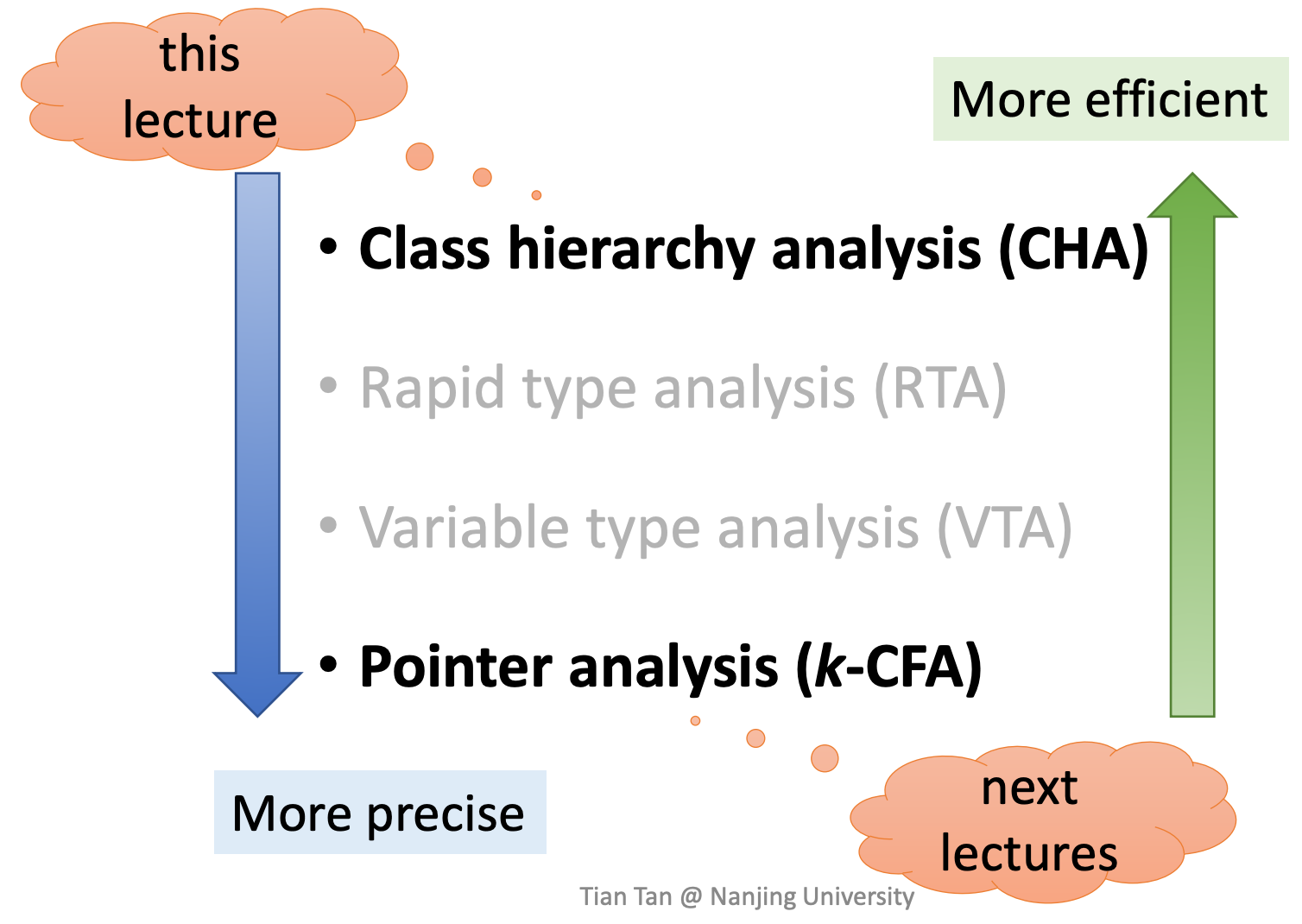
Call types in Java
本课主要关注Java的调用关系图构建。为此,我们需要先了解Java中调用的类型。Java中call可分为三类:
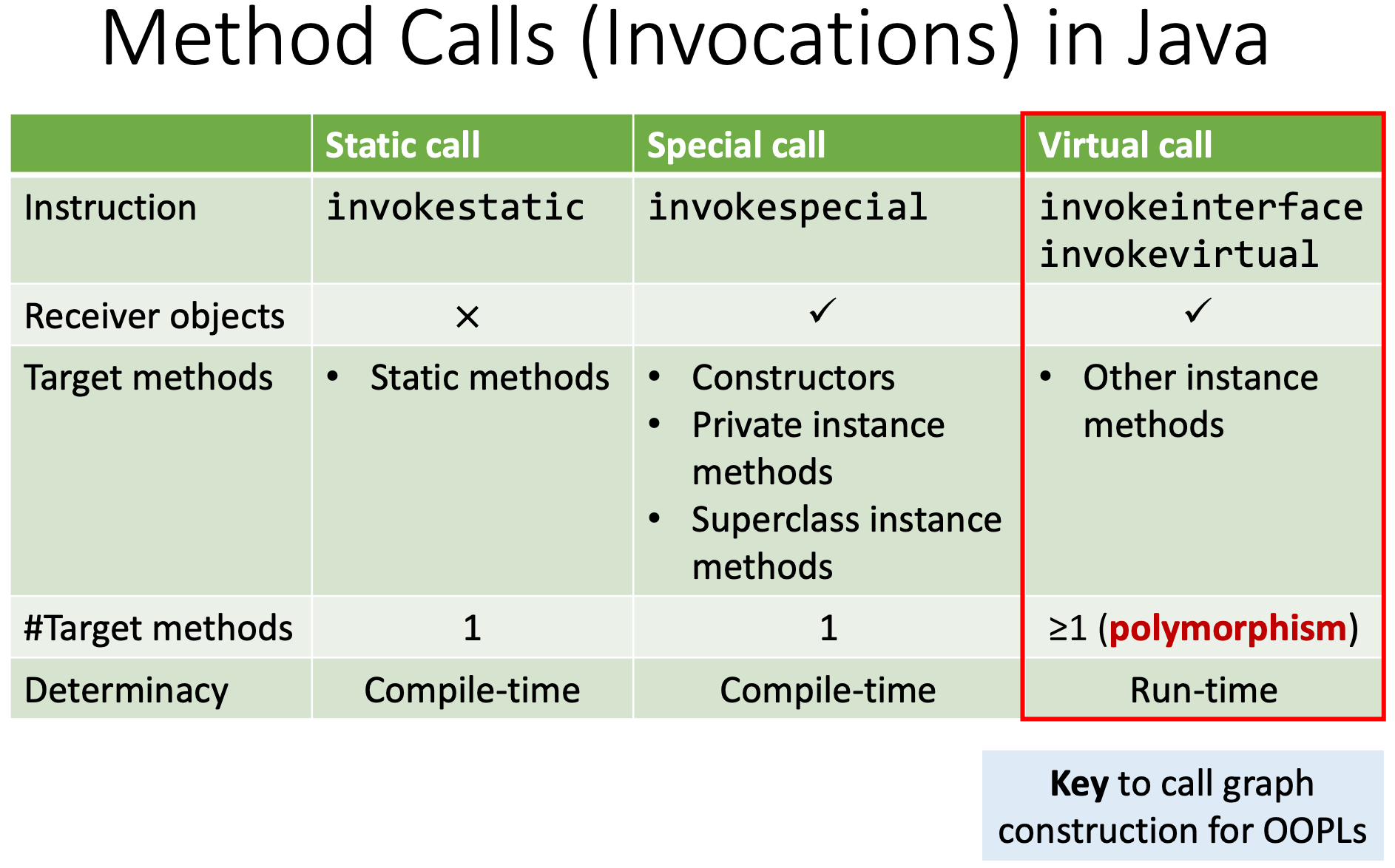
- Instruction:指Java的IR中的指令
- Receiver objects:方法调用对应的实例对象(static方法调用不需要对应实例)
- Target methods:表达IR指令到被调用目标方法的映射关系
- Num of target methods:call对应的可能被调用的目标方法的数量。Virtual call与动态绑定和多态实现有关,可以对应多个对象下的重写方法。所以Virtual call的可能对象可能超过1个
- Determinacy:指什么时候能够确定这个call的对应方法。Virtual call与多态有关,只能在运行时决定调用哪一个具体方法的实现。其他两种call都和多态机制不相关,编译时刻就可以确定
Method Dispatch of Virtual Calls
由于多态和receiver在静态分析时不能确定的原因,java的Virtual call的实际调用函数需要在运行代码时确定,在静态分析时是无法确定其准确值的。在动态运行时,Virtual call基于两点决定调用哪个具体方法:
- type of the receiver object (pointed by o):c
- method signature at the call site:m。In this lecture, a signature acts as an identifier of a method
- Signature = class type + method name + descriptor
- Descriptor = return type + parameter types

We define function Dispatch(𝑐, 𝑚) to simulate the procedure of run-time method dispatch

Dispatch: An Example
在实际执行时,需要根据调用的对象和调用的方法来找到最终调用的实际函数。举一个例子说明如何采用Dispatch的方式进行查找。

在这个例子中,
- x.foo()的receiver是x,receiver type是B,因为在class B中找不到和方法调用同名的非抽象方法声明,因此继续搜索class B的父类,即class A,因此dispatch结果为A.foo()
- x.foo()的receiver是x,receiver type是C,因为在class C中找到了和方法调用同名的非抽象方法声明,因此dispatch结果为C.foo()
Class Hierarchy Analysis* (CHA):Call Graph Construction的关键环节
Definition of CHA
- Require the class hierarchy information (inheritance structure) of the whole program
- 需要首先获得整个程序的类继承关系图
- Resolve a virtual call based on the declared type of receiver variable of the call site
- 通过接收变量的声明类型来解析Virtual call
- 接收变量的例子:在a.foo()中,a就是接收变量

- Assume the receiver variable a may point to objects of class A or all subclasses of A(Resolve target methods by looking up the class hierarchy of class A)
- 假设一个接收变量能够指向A或A的所有子类
Call Resolution of CHA
总结一下CHA算法,

Algorithm of Resolve
We define function Resolve(𝑐𝑐𝑠𝑠) to resolve possible target methods of a call site 𝑐𝑐𝑐𝑐 by CHA
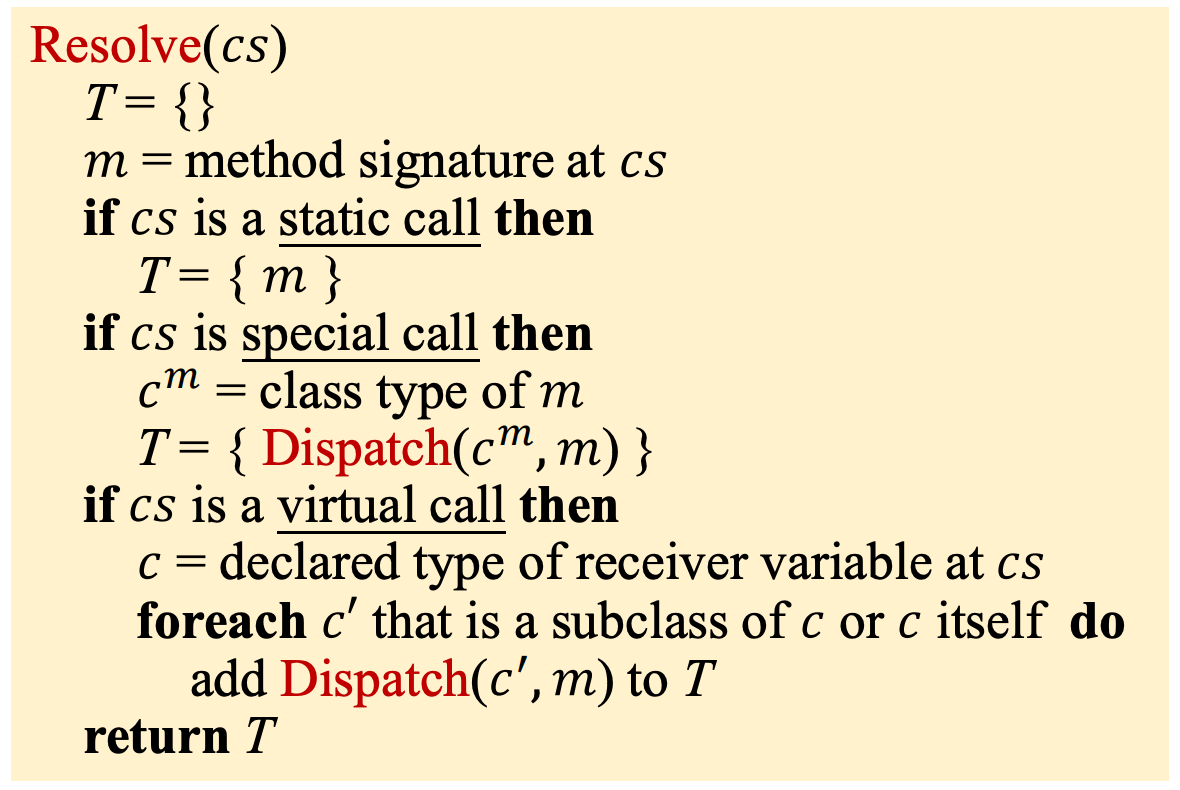
- call site(cs)就是调用语句,m(method)就是对应的函数签名。
- T集合中保存找到的结果
- 三个if分支分别对应之前提到的Java中的三种call类型
- Static call(所有的静态方法调用)
- Special call(使用super关键字的调用,构造函数调用和Private instance method)
- Virtual call(其他所有调用)
Static call
具体来说,静态方法调用前写的是类名,而非静态方法调用前写的是变量或指针名。静态方法调用不需要依赖实例。

Special call
Superclass instance method(super关键字)最为复杂,故优先考虑这种情况

为什么处理super调用需要使用Dispatch函数?
在下图所示情况中没有Dispatch函数时无法正确解析C类的super.foo调用:

而Private instance method和Constructor(一定由类实现或有默认的构造函数)都会在本类的实现中给出,使用Dispatch函数能够将这三种情况都包含,简化代码。
Virtual call
receiver variable在例子中就是c。

对receiver c和c的所有直接间接子类都作为call site调用Dispatch
CHA:Examples

- Resolve(c.foo()) = {C.foo()}:class C重新定义了foo(),所以c.foo()是一个普通私有函数调用,因此Resolve(c.foo()) = {C.foo()}
- Resolve(a.foo()) = {A.foo(),C.foo(),D.foo()}:a.foo()是一个virtual call,所以要对class A及其所有子类进行递归查找,因此Resolve(a.foo()) = {A.foo(),C.foo(),D.foo()}
- Resolve(b.foo()) = {A.foo(),C.foo(),D.foo()}:b.foo()是一个virtual call,所以要对class B及其所有子类进行递归查找,因此Resolve(a.foo()) = {A.foo(),C.foo(),D.foo()}

CHA in IDE (IntelliJ IDEA)

Features of CHA
- Advantage: fast
- Only consider the declared type of receiver variable at the call-site, and its inheritance hierarchy
- Ignore data- and control-flow information
- Disadvantage: imprecise
- Easily introduce spurious target methods
- Addressed in next lectures
Call Graph Construction: Algorithm
Idea
- Build call graph for whole program via CHA
- 通过CHA构造整个程序的call graph
- Start from entry methods (focus on main method)
- 通常从main函数开始
- For each reachable method 𝑚, resolve target methods for each call site 𝑐𝑠 in 𝑚 via CHA (Resolve(𝑐𝑠))
- 递归地处理每个可达的方法
- Repeat until no new method is discovered
- 当不能拓展新的可达方法时停止
- 整个过程和计算理论中求闭包的过程很相似

Algorithm

- Worklist:记录需要处理的methods
- Call graph:需要构建的目标,是call edges的集合
- Reachable method (RM):已经处理过的目标,在Worklist中取新目标时,不需要再次处理已经在RM中的目标
Example
1、初始化

2、处理main后向WL中加入A.foo()

3、继续分析,由于A.foo()之前已经处理过(在集合RM中),之后不会再进行处理

4、继续分析a.bar(),按照virtual call的规则进行may analyzes
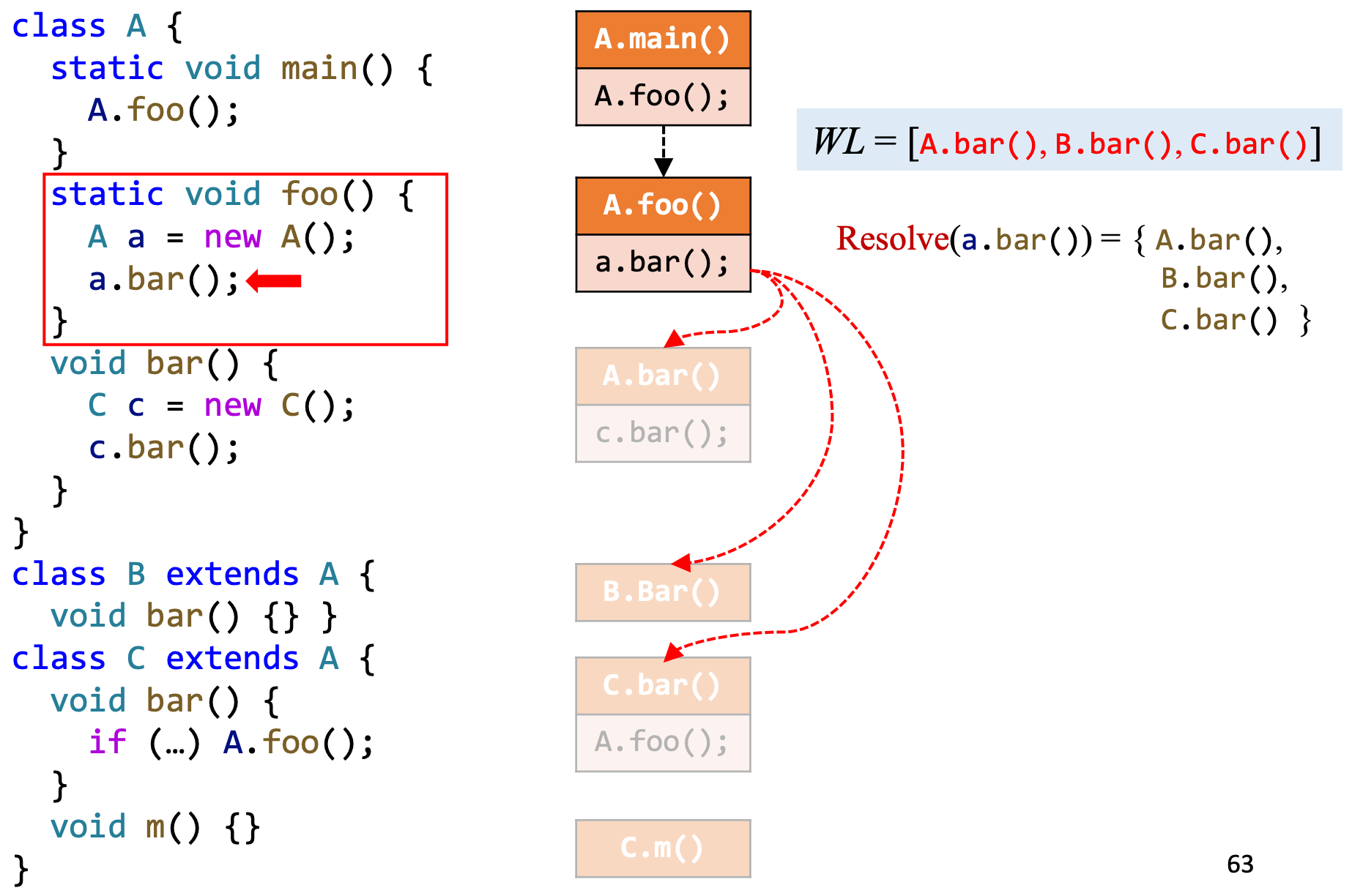
5、处理c.bar()

6、处理B.bar(),因为B.bar()没有新的callsite,也没有继承子类,跳过

7、继续分析,由于A.foo()之前已经处理过(在集合RM中),之后不会再进行处理

8、C.m()是不可达的死代码

三、Interprocedural Control-Flow Graph
- CFG represents structure of an individual method
- ICFG represents structure of the whole program,With ICFG, we can perform interprocedural analysis
- ICFG = CFGs + call & return edges
- Call edges: from call sites to the entry nodes of their callees
- Return edges: from exit nodes of the callees to the statements following their call sites (i.e., return sites)


四、Interprocedural Data-Flow Analysis
Analyzing the whole program with method calls based on interprocedural control-flow graph (ICFG).
定义与比较

Edge transfer处理引入的call & return edge。为此,我们需要在CFG基础上增加三种transfer函数。
- Call edge transfer:从调用者向被调用者传递参数
- Return edge transfer:被调用者向调用者传递返回值
- Node transfer:大部分与过程内的常数传播分析一样,不过对于每一个函数调用,都要kill掉LHS(Left hand side)的变量

下面以常量传播为例子进行解释。
- Node transfer
- Call nodes: identity
- Other nodes: same as intraprocedural constant propagation
- Edge transfer
- Normal edges: identity
- Call-to-return edges: kill the value of LHS variable of the
- call site, propagate values of other local variables
- Call edges: pass argument values
- Return edges: pass return values

要记得在调用语句处kill掉表达式左边的值,否则会造成结果的不准确,如:

kill掉callsite b的左值后如下:


这里有一个问题要思考一下,这一段有存在的必要吗?

Such edge (from call site to return site) is named call-to-return edge. It allows the analysis to propagate local data-flow (a=6 in this case) on ICFG.
如果没有这一段,那么a就得“出国”去浪费地球资源——在分析被调用函数的全程中都需要记住a的值,这在程序运行时会浪费大量内存。

五、How Important Interprocedural Data-Flow Analysis
还是看上章的常量传播的例子, 而如果只做过程内分析,则精度大大下降:
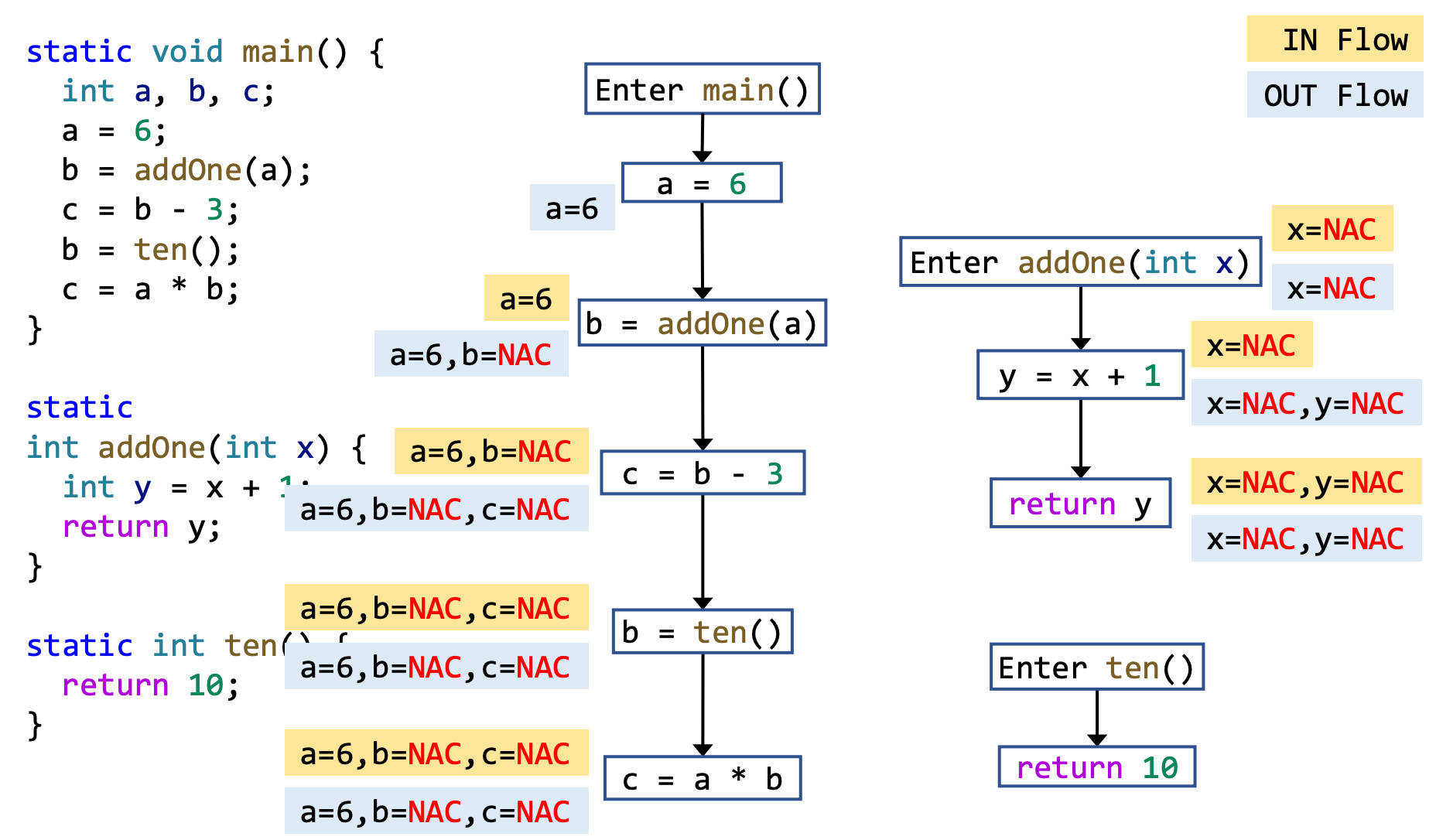
应用过程间分析的完整推导如下:



 浙公网安备 33010602011771号
浙公网安备 33010602011771号